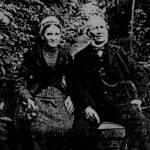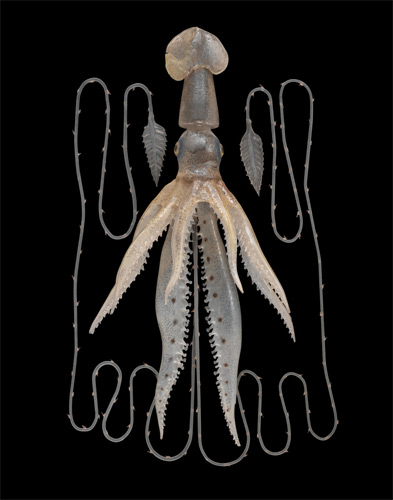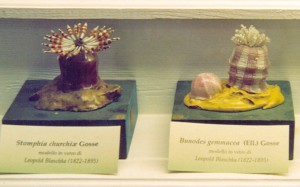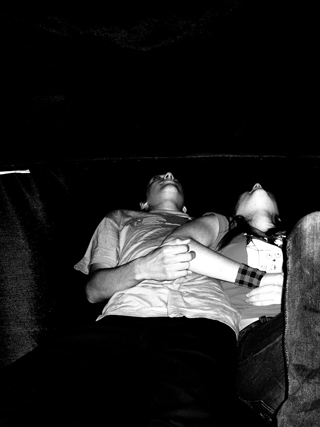Leopold Blaschkas (1822-1895) came from a long line of skilled glass makers. The family was originally from Venice, but lived in Bohemia, (what is now the Czech Republic). When young Leopold studied to become a goldsmith and gem cutter but then joined the family business and his main work was to produce glass eyes.

 In 1857 his son Rudolph was born but shortly after two tragedies occurred in his life, his wife died in an cholera epidemic and two years later his father too. It was hard on him but he found a way to deal with his sorrow. He was artistically talented and started to look at the nature for inspiration, and sketched what he saw, plants and animals from outside his home and in exotic natural books he found. And then, on a boat trip to south America, he spend his time looking out in the sea around him. There he got struck by and fascinated by the sea animals he saw, those without
In 1857 his son Rudolph was born but shortly after two tragedies occurred in his life, his wife died in an cholera epidemic and two years later his father too. It was hard on him but he found a way to deal with his sorrow. He was artistically talented and started to look at the nature for inspiration, and sketched what he saw, plants and animals from outside his home and in exotic natural books he found. And then, on a boat trip to south America, he spend his time looking out in the sea around him. There he got struck by and fascinated by the sea animals he saw, those without
backbones especially, because of the transparency of their skin surface, which reminded him of the glass he was used working with as the glass master he was.
because of the transparency of their skin surface, which reminded him of the glass he was used working with as the glass master he was.
Although he was already one, he and became even more a passionate nature history lover and as a hobby he recreated both plants and animals in glass. After his encounter with sea animals he started making them in glass and then became one of the first who recreated animals from the sea in an accurate way, at that time you couldn’t take photographs under water.
In the late 1850s Leopold was commissioned by a Mr. Prince Camille de Rohan to create 100 glass models of a orchid collection Leopold already had started to work on. His models then got exhibited in Dresden Natural History Museum, This was the start of his career.
Normally at the time the only way of preserving plants and animals in science purposes was to press them or put them in jars with alcohol. But it wasn’t ideal, the color faded away quickly and collapsed on the bottom of the jar. Something had to be done and the way Blaschkas treated both flowers and animals, with precise skills and in glass, they stood out and was the best choice. That at least a professor called George Lincoln Goodale thought. During that time he was working for Harvard, which was the center of teaching and researching science in America. He was trusted to create a Botanical museum for the University and he made his research. He could have chosen to use pressed specimens and drawings of them, they keep their color and shape better than preserved objects in alcohol. But a big problem was that pressed plants and drawings weren’t three-dimensional and therefore not a good choice for representing the reality in the museum he thought.
 One day he saw one of the Blaschkas models and was convinced that they were the answer. They looked both realistic and didn’t loose color or shape with time. He went to visit the Blaschkas and persuade them to produce models for him. They made some and shipped them when finished to Harvard. Unfortunately they were badly damaged, but Goodale was convinced when holding them in his hands that the glass models was the right way to go and there after Leopold and his son Rudolph which became his partner produced over 4000 models for Harvard and even more to other places in the world.
One day he saw one of the Blaschkas models and was convinced that they were the answer. They looked both realistic and didn’t loose color or shape with time. He went to visit the Blaschkas and persuade them to produce models for him. They made some and shipped them when finished to Harvard. Unfortunately they were badly damaged, but Goodale was convinced when holding them in his hands that the glass models was the right way to go and there after Leopold and his son Rudolph which became his partner produced over 4000 models for Harvard and even more to other places in the world.
The life-size models include 847 species, copied almost one to one, amazingly accurate. Their work has been hailed as: “an artistic marvel in the field of science and a scientific marvel in the field of art.”
Leopold Blaschka himself said about his work “Many people think that we have some secret apparatus by which we can squeeze glass suddenly into these forms, but it is not so. We have tact”
The knowledge of making these glass models died out with son Rudolf Blaschka since he never got children. No one managed to imitate the technique and that makes it problematic today in repairing and maintaining the models. The models are aging and in some cases also falling apart. But even though the glass models are almost 200 years old they are still contemporary and still highly interesting for both science world and the art/design world and is still exhibited and discussed. Now we have good photographs and computers etc that can imitate nature in realistic ways but Blaschkas models still fascinates. Why? Could it be that they are not only works in the name of science but also art pieces?
Reality and what reality offers is a fascinating subject and a good design and art recipe. It is also our drive as human beings, to deal with the reality, take situations and objects out of its place and deal with them, in a way of understanding and maybe also for therapeutically reasons. Because that is why Leopold started his glass models in first place? After the death of his wife, he depicted the reality and nature around him. The glass models are the result of a human drive of dealing with life. I cannot stop and wonder who they were as persons, the Blaschkas, more than magic there is an obsession behind their work, when adding the huge amounts of models they made. I admirer the patience and love they seem to have put in their work.
 And if I think about crafts. That I think a good craftsmanship is important. I think it is refreshing and beautiful to see the models in this world today where both art and design goes further and further away from hand and replaced by brain in my opinion. There is something sad in that because I wonder if brain can touch as well as hand can.
And if I think about crafts. That I think a good craftsmanship is important. I think it is refreshing and beautiful to see the models in this world today where both art and design goes further and further away from hand and replaced by brain in my opinion. There is something sad in that because I wonder if brain can touch as well as hand can.
If you want to listen to the story in detail use this link
or download this article by Dawston on "Glass Flowers" as a pdf




